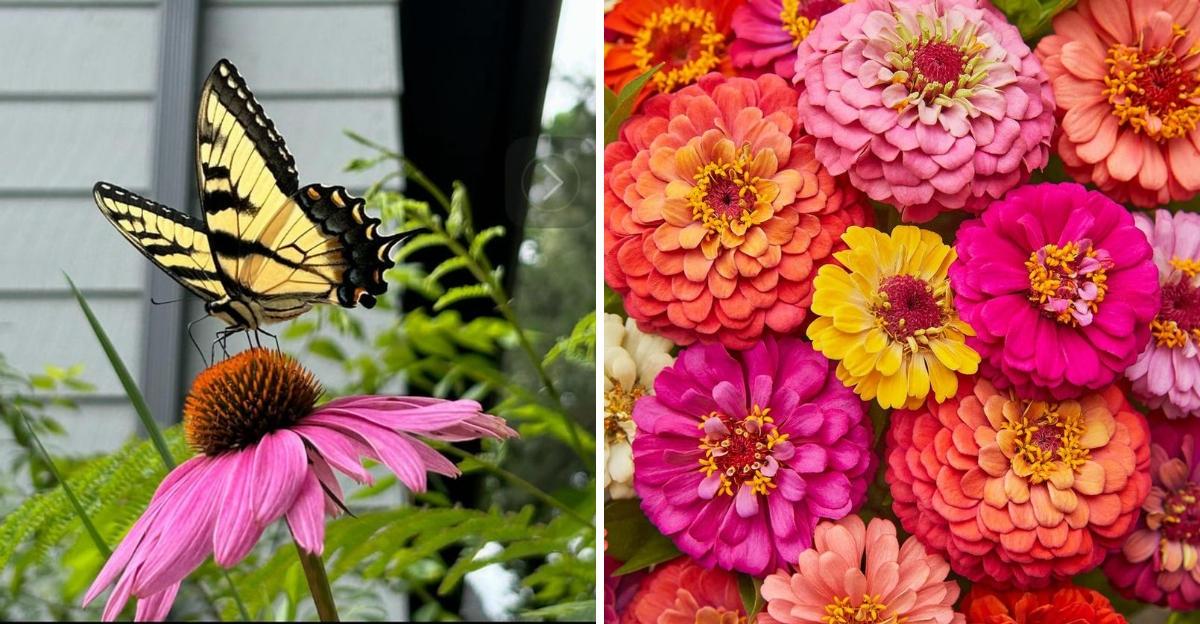12 Kid-Friendly Plants That Are Safe For Families In Pennsylvania

Gardening with kids can be a wonderful family activity, but safety comes first when little curious hands and mouths are around. As a Pennsylvania gardener with young children, I’ve researched extensively to find plants that won’t cause harm if accidentally touched or tasted.
These 12 kid-friendly plants not only create a safer outdoor environment but also provide fantastic opportunities to teach children about nature and responsibility.
1. Sunflowers: The Cheerful Giants
Nothing brings more smiles to a family garden than the bright faces of sunflowers tracking the sun across the sky. My kids love planting these seeds and watching them grow taller than daddy in just weeks!
Sunflowers are completely non-toxic to children and pets, making them perfect for family gardens. The large seeds are easy for small hands to plant, and harvesting them later becomes a tasty lesson in patience.
We use the mature stalks as natural measuring sticks to track how much our children have grown throughout the summer.
2. Snapdragons: Nature’s Puppet Show
Remember squeezing the sides of these flowers to make them ‘talk’ when you were little? I’ve passed this magical garden tradition to my own children, who spend hours creating flower puppet shows.
Snapdragons are completely non-toxic and come in a rainbow of colors that brighten any Pennsylvania garden from spring through fall. Their cold hardiness makes them perfect for our unpredictable spring weather.
The vertical growth creates a wonderful backdrop for shorter plants while providing endless entertainment for tiny fingers discovering how the ‘dragon mouths’ open and close.
3. Lamb’s Ear: The Touchably Soft Plant
Fuzzy, velvety leaves make lamb’s ear the teddy bear of my garden! The silvery-green foliage feels like the softest blanket, inviting little fingers to stroke and pet them during garden explorations.
This hardy perennial thrives in Pennsylvania’s climate and stands up well to curious handling. My toddler calls these our ‘bunny plants’ and checks on them first thing during garden visits.
Beyond being completely safe for children, lamb’s ear teaches kids about different plant textures while adding beautiful contrast to colorful flowers nearby.
4. Marigolds: Natural Garden Protectors
The bright orange and yellow blooms of marigolds bring both beauty and benefits to our family garden. My children call them ‘sunshine flowers’ because they seem to glow even on cloudy Pennsylvania days.
Completely non-toxic and easy to grow, marigolds naturally repel many garden pests that would otherwise damage nearby vegetables. We plant them as colorful borders around our tomatoes and cucumbers.
Kids love collecting the spent blooms and saving the seeds – a perfect introduction to the plant life cycle and a free supply for next year’s garden!
5. Nasturtiums: Edible Flowers for Brave Tasters
The peppery taste of nasturtium flowers has turned my cautious eaters into adventurous food explorers! These bright blooms in orange, yellow and red create a stunning display while being completely edible – flowers, leaves and all.
Growing easily from large seeds that little fingers can handle, nasturtiums thrive in Pennsylvania’s summer climate. They don’t mind poor soil, making them perfect for children’s first gardening projects.
We add the colorful flowers to salads and sandwiches, creating meals that my kids proudly announce they ‘grew themselves’ – a sure way to get them eating more vegetables!
6. Boston Ferns: Shade-Loving Beauties
Feathery fronds create magical hideaways on our shaded porch each summer. Boston ferns have become our go-to hanging plants for adding lush greenery without worry about toxicity around curious children.
My kids love misting these plants with spray bottles, turning plant care into water play. The bright green foliage thrives in Pennsylvania’s humid summer months and provides a tropical feel to shaded areas.
We’ve turned caring for our Boston ferns into a family responsibility chart, teaching gentle plant handling while creating beautiful, child-safe green spaces around our home.
7. Purple Coneflowers: Butterfly Magnets
My family’s butterfly-watching adventures begin with purple coneflowers! These native Pennsylvania perennials attract colorful visitors that mesmerize children for hours of nature observation.
The distinctive purple petals surrounding orange-brown centers aren’t just beautiful – they’re completely non-toxic and tough enough to withstand enthusiastic little gardeners. Their deep roots help them survive Pennsylvania’s occasional summer dry spells.
We keep a butterfly identification chart near our coneflower patch, turning casual garden time into educational wildlife spotting that even my screen-loving kids prefer over video games.
8. Spider Plants: Indoor Air Purifiers
The arching green and white leaves of spider plants have earned them the nickname ‘airplane plants’ in our home. My children love watching the tiny ‘babies’ dangle from long stems like miniature aircraft ready for takeoff.
Spider plants rank among NASA’s top air-purifying houseplants while remaining completely non-toxic to children and pets. Their resilient nature forgives irregular watering – perfect for when little helpers get distracted!
We propagate the baby plants in water, creating science lessons about root development before gifting the new plants to friends and family, spreading both greenery and gardening enthusiasm.
9. Zinnia Flowers: Easy-Grow Rainbow
From seed to bloom in just weeks, zinnias deliver almost instant garden gratification for impatient young gardeners! The explosion of colors transforms our Pennsylvania garden into a rainbow that blooms until first frost.
My kids each choose different colored zinnia seeds to plant in their own garden sections, creating a friendly growing competition. The large seeds are perfect for small hands, and the sturdy stems hold up well to enthusiastic flower picking.
We create weekly bouquets for the dinner table, teaching flower arranging while enjoying completely non-toxic blooms that keep producing the more we harvest.
10. Christmas Cactus: Holiday Tradition
Unlike its desert cousins with sharp spines, Christmas cactus offers soft, smooth segments that cascade beautifully from pots without any risk to curious little fingers. The winter blooms have become our family’s signal that holiday season has officially begun!
This long-lived houseplant often becomes a family heirloom, passed through generations. My children help track the light exposure in fall to encourage maximum flowering around Christmas time.
The pink, red, or white blooms brighten Pennsylvania’s gray winter days while teaching kids about different plant families and seasonal care requirements – all with zero toxicity concerns.
11. Mint: Fragrant Sensory Experience
The refreshing scent of mint creates an instant sensory garden experience that delights children of all ages. My kids have created a game of ‘guess the mint variety’ as we’ve expanded our collection to include peppermint, spearmint, and chocolate mint.
Growing mint in containers prevents its spreading habit while keeping it easily accessible for little hands to touch and smell. The sturdy stems and leaves hold up well to regular harvesting and exploration.
We use our mint for homemade tea, dessert garnishes, and natural air fresheners – turning a completely safe plant into practical household uses that children can participate in creating.
12. Lemon Balm: Calming Herb Garden Addition
The gentle lemony scent of this herb works magic on cranky moods! My family’s end-of-day garden ritual includes rubbing lemon balm leaves between our fingers while sharing the day’s highlights and challenges.
Part of the mint family but with a distinctive citrus fragrance, lemon balm grows easily in Pennsylvania gardens. The bright green leaves stay lush even during hot summers when regularly harvested.
We add the leaves to water pitchers, creating naturally flavored drinks that my children prefer over sugary options. The mild taste and complete safety make it perfect for young gardeners learning about edible plants.






